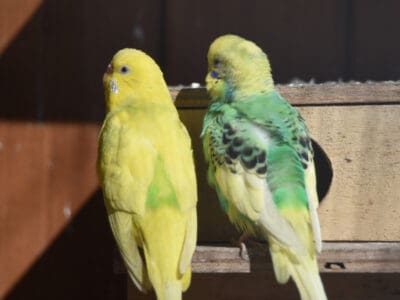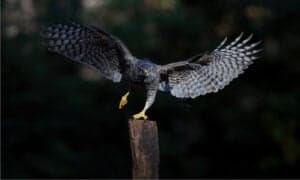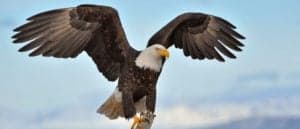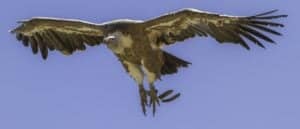Silkie Hen vs Rooster: What Are the Differences?
@media (min-width: 481px) {
.mobile-top-content {
display: none;
}
}
#mobileTopContentCTACarouselControls { overflow: hidden; text-overflow: ellipsis; white-space: nowrap; }
.mobile-top-content .more { color: #fff; }
.mobile-top-content a { color: #fff; text-decoration: underline; }
.mobile-top-content a:hover { color: #fff; text-decoration: underline; }
@media (max-width: 480px) {
.mobile-top-content {
background-color: #06a10b;
color: #fff;
text-align: center;
/*height: 60px;
padding-top:5px;*/
font-size:80%;
/* display: block; */
margin: 0px -30px;
}
}
The silkie chicken is one of the most unique regular chicken and bantam chicken breeds in the world today. Hailing from China, these birds are just as often used as companions as they are as livestock. They have exotic plumage and are known for their willingness to brood on all sorts of eggs. Like many other birds, silkie chickens are sexually dimorphic so they have differences between them as they mature. We’re going to show you the differences between a silkie hen vs rooster.
Whether you are just curious about their unique traits or you’re trying to sex your flock, this information will help you tell the males apart from the females in this popular chicken breed.
As a note, we’re going to use information about the U.S. standard breed and not data about the smaller bantams in Australia and Britain.
button.pulse {
transform: scale(1); animation: pulse 2s infinite;
box-shadow: 0 0 0 0 rgba(11, 247, 25, 1);
}
@keyframes pulse {
0% { transform: scale(0.90); box-shadow: 0 0 0 0 rgba(11, 247, 25, 0.5); }
60% { transform: scale(1); box-shadow: 0 0 0 15px rgba(11, 247, 25, 0); }
100% { transform: scale(0.90); box-shadow: 0 0 0 0 rgba(11, 247, 25, 0); }
}
Comparing a Silkie Hen and a Silkie Rooster
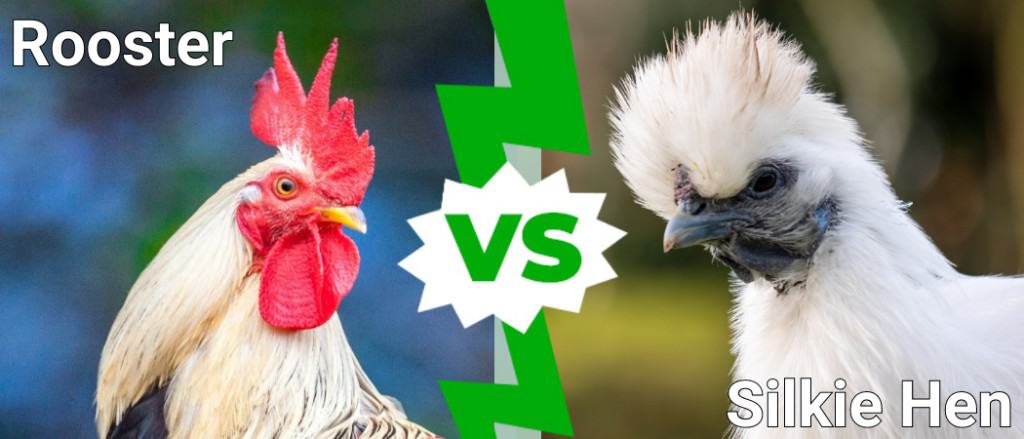
A-Z-Animals.com
| Silkie Hen | Silkie Rooster | |
| Size | Weight: 1.5lbs- 3lbs Height: 8in-14in | Weight: 2lbs-4lbs Height: 8in-14in |
| Wattles | Wattle develops later in life than a rooster and remains smaller | Wattle develops faster than hen’s and grows larger |
| Comb | Smaller, V-shaped comb | Larger “Walnut-shaped” comb |
| Crown Feathers | Rounded, uniform length in crown feathers | Longer, less-uniform crown feathers called “streamer feathers” |
| Spurs | Silkies hens do not grow spurs | Silkie roosters grow spurs that can reach about an inch in length |
The Key Differences Between Silkie Hen vs Silkie Rooster
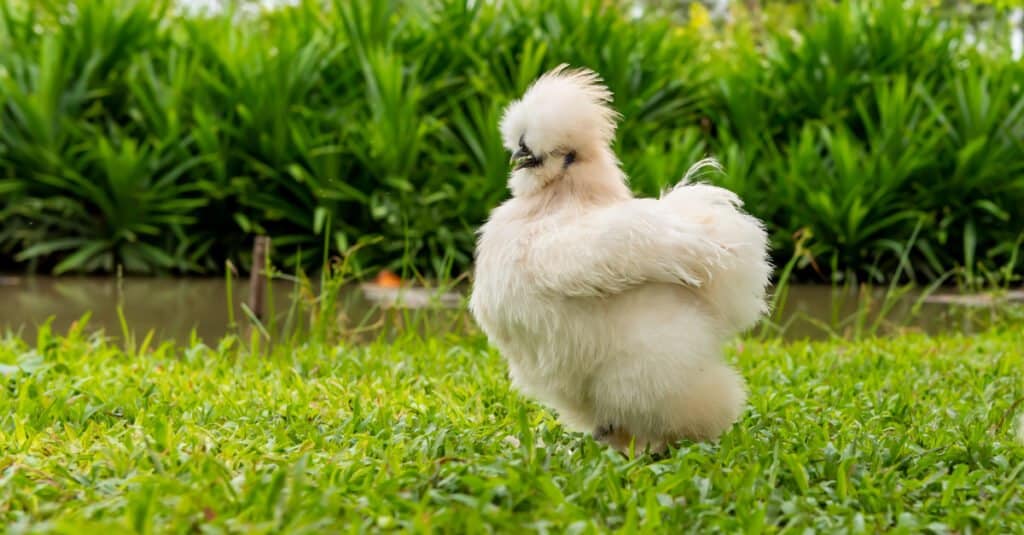
MR. AEKALAK CHIAMCHAROEN/Shutterstock.com
The greatest differences between silkie hens and roosters are their size, wattles, and crown feathers. Silkie roosters are larger than silkie hens, and they develop a wattle earlier in life that grows larger than females’ wattles, and roosters have crown feathers while hens do not.
These differences make it easy to tell if these chickens are male or female. The only drawback is that many of these changes do not happen until the chickens are fully mature. Thus, sexing these younger chickens can be very difficult.
Silkie Hen vs Silkie Rooster: Size
Silkie hens are smaller than silkie roosters. The average silkie hen may grow between 8 and 14 inches and will reach a top weight of 3lbs or just slightly under. A silkie rooster will also grow between 8 and 14 inches, but it’s more likely than the hen to reach the higher measurement. The silkie rooster will also weigh between 2 and 4lbs, and that’s noticeably larger than a hen.
Silkie Hen vs Silkie Rooster: Wattles
Silkie hens’ wattles develop later in life than a rooster and they’re smaller than their male counterparts. A silkie rooster’s wattle begins to develop between three and four weeks of age, but it doesn’t start growing until slightly later in a silkie hen.
Both creatures have wattles, but a silkie rooster’s wattle tends to be much larger than a hen’s, growing far longer. Moreover, when you combine the sight of the comb and wattle for your silkie, you’ll know right away whether it’s a hen or rooster.
Silkie Hen vs Silkie Rooster: Comb

Andi111/Shutterstock.com
A silkie hen’s comb is smaller and differently shaped than a silkie rooster’s comb. Not only does a silkie hen have a smaller comb than a silkie rooster, and it’s V-shaped.
A silkie rooster’s comb is often much larger than a hen’s comb, and it’s considered “walnut-shaped”, so it appears to be large, wrinkled in some parts, and bulbous overall. A silkie’s rooster’s comb can be the defining feature of its head, and it certainly stands out compared to the hen’s.
Silkie Hen vs Silkie Rooster: Crown Feathers
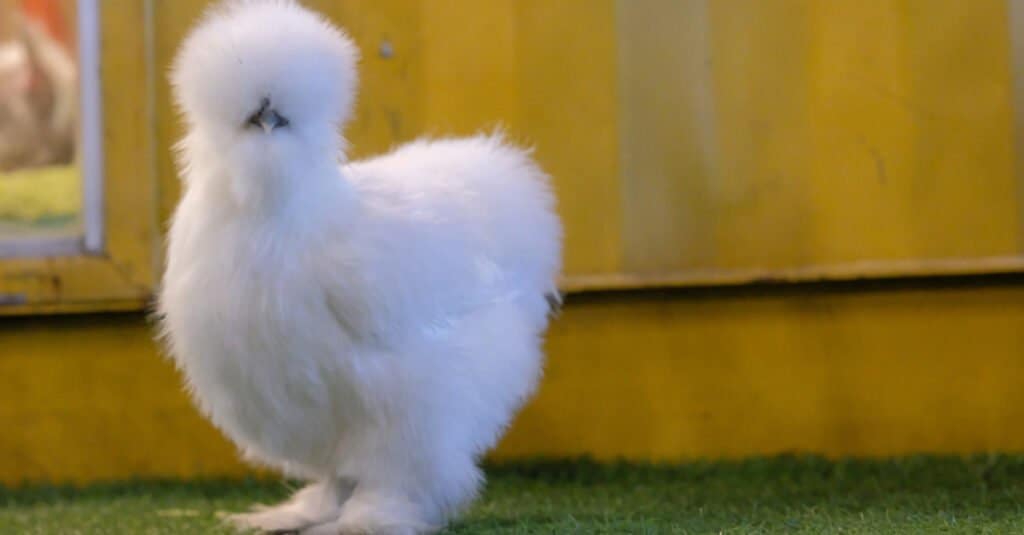
Hand Robot/Shutterstock.com
Silkie hens do not have more uniform and round crown feathers compared with a rooster. If you were to look directly down on a silkie hen’s head, you would notice that it has a large tuft of crown feathers. The overall shape of the crown feathers is round, and the feathers are a neat, tight crop of hair.
The same cannot be said about the silkie rooster. They have a square-like shape to their plume of crown feathers. Also, not all of their crown feathers are the same size. They have what is known as “streamer feathers” that grow taller than any other ones on their head. Overall, the silkie rooster’s crown feathers look a lot messier than those on a hen.
The presence of streamer feathers and the overall shape of the feathers on their crown is a defining feature of the silkie rooster.
Silkie Hen vs Silkie Rooster: Spurs
A silkie rooster has spurs but a silkie hen does not have spurs. Basically, spurs are long toenails that roosters develop, and they are used much in the same way as other birds’ talons.
These spurs are rarely seen on hens and when they are, it’s usually several years into the chicken’s lifespan. That being said, these spurs are something that people need to watch out for in their silkies because the rooster’s spurs need to be tended to regularly. If they grow too long, they can make it hard for the chicken to walk or even cut into their skin.
Other Ways to Determine Sex in Your Silkie

Although the aforementioned data might help you figure out the differences between a silkie hen vs rooster, you might need more data to help properly sex silkie chickens if you’re not overly experienced at determining the sex of a young bird.
For one thing, you can look at the posture of the silkies. Silkie roosters will stand more upright, and they will often hold their tails higher than females. The silkie hen will usually hold their bodies more horizontally to the ground.
You can also look at their feet because males will have thicker feathers on their feet compared to females. Unfortunately, you can only use this method of sexing if the chickens you are comparing belong to the same brood since this trait is passed down from the parents.
Lastly, you could consider the crowing behavior of your chickens. Silkie roosters will start crowing when they reach about 4 or 5 months of age. The vast majority of hens will not actively crow unless they’re trying to establish a position for themselves in the “pecking order” or they are wholly unique.
These differences between silkie hens and roosters should make identifying them easy, especially as they get older and their differences become more noticeable.
More from A-Z Animals
.more-snake-card-image { max-height:140px !important; }
@media (min-width: 481px) {
.mobile-top-content {
display: none;
}
}
#mobileTopContentCTACarouselControls { overflow: hidden; text-overflow: ellipsis; white-space: nowrap; }
.mobile-top-content .more { color: #fff; }
.mobile-top-content a { color: #fff; text-decoration: underline; }
.mobile-top-content a:hover { color: #fff; text-decoration: underline; }
@media (max-width: 480px) {
.mobile-top-content {
background-color: #06a10b;
color: #fff;
text-align: center;
/*height: 60px;
padding-top:5px;*/
font-size:80%;
/* display: block; */
margin: 0px -30px;
}
}
The silkie chicken is one of the most unique regular chicken and bantam chicken breeds in the world today. Hailing from China, these birds are just as often used as companions as they are as livestock. They have exotic plumage and are known for their willingness to brood on all sorts of eggs. Like many other birds, silkie chickens are sexually dimorphic so they have differences between them as they mature. We’re going to show you the differences between a silkie hen vs rooster.
Whether you are just curious about their unique traits or you’re trying to sex your flock, this information will help you tell the males apart from the females in this popular chicken breed.
As a note, we’re going to use information about the U.S. standard breed and not data about the smaller bantams in Australia and Britain.
button.pulse {
transform: scale(1); animation: pulse 2s infinite;
box-shadow: 0 0 0 0 rgba(11, 247, 25, 1);
}
@keyframes pulse {
0% { transform: scale(0.90); box-shadow: 0 0 0 0 rgba(11, 247, 25, 0.5); }
60% { transform: scale(1); box-shadow: 0 0 0 15px rgba(11, 247, 25, 0); }
100% { transform: scale(0.90); box-shadow: 0 0 0 0 rgba(11, 247, 25, 0); }
}
Comparing a Silkie Hen and a Silkie Rooster

A-Z-Animals.com
| Silkie Hen | Silkie Rooster | |
| Size | Weight: 1.5lbs- 3lbs Height: 8in-14in | Weight: 2lbs-4lbs Height: 8in-14in |
| Wattles | Wattle develops later in life than a rooster and remains smaller | Wattle develops faster than hen’s and grows larger |
| Comb | Smaller, V-shaped comb | Larger “Walnut-shaped” comb |
| Crown Feathers | Rounded, uniform length in crown feathers | Longer, less-uniform crown feathers called “streamer feathers” |
| Spurs | Silkies hens do not grow spurs | Silkie roosters grow spurs that can reach about an inch in length |
The Key Differences Between Silkie Hen vs Silkie Rooster

MR. AEKALAK CHIAMCHAROEN/Shutterstock.com
The greatest differences between silkie hens and roosters are their size, wattles, and crown feathers. Silkie roosters are larger than silkie hens, and they develop a wattle earlier in life that grows larger than females’ wattles, and roosters have crown feathers while hens do not.
These differences make it easy to tell if these chickens are male or female. The only drawback is that many of these changes do not happen until the chickens are fully mature. Thus, sexing these younger chickens can be very difficult.
Silkie Hen vs Silkie Rooster: Size
Silkie hens are smaller than silkie roosters. The average silkie hen may grow between 8 and 14 inches and will reach a top weight of 3lbs or just slightly under. A silkie rooster will also grow between 8 and 14 inches, but it’s more likely than the hen to reach the higher measurement. The silkie rooster will also weigh between 2 and 4lbs, and that’s noticeably larger than a hen.
Silkie Hen vs Silkie Rooster: Wattles
Silkie hens’ wattles develop later in life than a rooster and they’re smaller than their male counterparts. A silkie rooster’s wattle begins to develop between three and four weeks of age, but it doesn’t start growing until slightly later in a silkie hen.
Both creatures have wattles, but a silkie rooster’s wattle tends to be much larger than a hen’s, growing far longer. Moreover, when you combine the sight of the comb and wattle for your silkie, you’ll know right away whether it’s a hen or rooster.
Silkie Hen vs Silkie Rooster: Comb

Andi111/Shutterstock.com
A silkie hen’s comb is smaller and differently shaped than a silkie rooster’s comb. Not only does a silkie hen have a smaller comb than a silkie rooster, and it’s V-shaped.
A silkie rooster’s comb is often much larger than a hen’s comb, and it’s considered “walnut-shaped”, so it appears to be large, wrinkled in some parts, and bulbous overall. A silkie’s rooster’s comb can be the defining feature of its head, and it certainly stands out compared to the hen’s.
Silkie Hen vs Silkie Rooster: Crown Feathers

Hand Robot/Shutterstock.com
Silkie hens do not have more uniform and round crown feathers compared with a rooster. If you were to look directly down on a silkie hen’s head, you would notice that it has a large tuft of crown feathers. The overall shape of the crown feathers is round, and the feathers are a neat, tight crop of hair.
The same cannot be said about the silkie rooster. They have a square-like shape to their plume of crown feathers. Also, not all of their crown feathers are the same size. They have what is known as “streamer feathers” that grow taller than any other ones on their head. Overall, the silkie rooster’s crown feathers look a lot messier than those on a hen.
The presence of streamer feathers and the overall shape of the feathers on their crown is a defining feature of the silkie rooster.
Silkie Hen vs Silkie Rooster: Spurs
A silkie rooster has spurs but a silkie hen does not have spurs. Basically, spurs are long toenails that roosters develop, and they are used much in the same way as other birds’ talons.
These spurs are rarely seen on hens and when they are, it’s usually several years into the chicken’s lifespan. That being said, these spurs are something that people need to watch out for in their silkies because the rooster’s spurs need to be tended to regularly. If they grow too long, they can make it hard for the chicken to walk or even cut into their skin.
Other Ways to Determine Sex in Your Silkie

Although the aforementioned data might help you figure out the differences between a silkie hen vs rooster, you might need more data to help properly sex silkie chickens if you’re not overly experienced at determining the sex of a young bird.
For one thing, you can look at the posture of the silkies. Silkie roosters will stand more upright, and they will often hold their tails higher than females. The silkie hen will usually hold their bodies more horizontally to the ground.
You can also look at their feet because males will have thicker feathers on their feet compared to females. Unfortunately, you can only use this method of sexing if the chickens you are comparing belong to the same brood since this trait is passed down from the parents.
Lastly, you could consider the crowing behavior of your chickens. Silkie roosters will start crowing when they reach about 4 or 5 months of age. The vast majority of hens will not actively crow unless they’re trying to establish a position for themselves in the “pecking order” or they are wholly unique.
These differences between silkie hens and roosters should make identifying them easy, especially as they get older and their differences become more noticeable.

